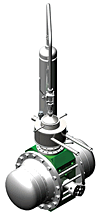Use of cryogenic cooling by the Deep Space Network (DSN) includes both open-cycle refrigeration (OCR) and closed-cycle refrigeration (CCR) systems.The temperatures achieved by these systems range from 1.5 kelvins (K) to about 80 K, depending upon the type of system used. These cryogenic systems are used to cool low-noise preamplifiers and some of the antenna feed system components for the DSN’s receivers. Liquid nitrogen (LN2) was used to cool reference loads (resistive terminations) used for noise temperature
 measurements, and liquid helium (LHe) was used to cool reference loads and antenna-mounted ruby masers. Russell B. Scott in Cryogenic Engineering explains many aspects of cryogenic technology in terms that are easily understood. Progress since 1959, has given us many types of CCR systems that can be used for cooling low-noise microwave amplifiers.Cryogenic refrigeration is a term that may be applied to the process of cooling equipment and components to temperatures below 150 K. The net capacity of a cryogenic refrigeration system at a particular temperature is the amount of heat that can be applied to a “cold station” in the system without warming the station above that particular temperature. The cold station may be a bath of cryogenic fluid, or the cold station may be a conductive surface cooled to the bath temperature to which equipment may be fastened.Cryogenic refrigeration systems are different from the refrigeration equipment we encounter in our everyday environment. The refrigerants used in cryogenic systems are often helium (He), hydrogen (H2), or nitrogen (N2).Insulation techniques used to minimize heat leaks into the cooled parts of the systems usually depend on the use of high-vacuum technology, radiation shields, and structural materials with low thermal conductivity. Systems that use stored cryogens such as liquid helium, liquid hydrogen, or liquid nitrogen in a container called a “dewar” are usually refilled on a periodic basis. Solidified gases (such as hydrogen or methane) can also be used for cooling purposes, much as solid carbon dioxide (dry ice) is used to refrigerate perishable foods during shipment, but this has not been done in the DSN.Development of cryogenic refrigeration equipment and systems for laboratory, military, and commercial purposes began many years before development of the ruby masers and other low-noise equipment used in the DSN. This was fortunate, but the personnel developing the DSN’s low-noise amplifiers did not have all of the knowledge and expertise needed for developing or purchasing cryogenic equipment and systems. There was much
measurements, and liquid helium (LHe) was used to cool reference loads and antenna-mounted ruby masers. Russell B. Scott in Cryogenic Engineering explains many aspects of cryogenic technology in terms that are easily understood. Progress since 1959, has given us many types of CCR systems that can be used for cooling low-noise microwave amplifiers.Cryogenic refrigeration is a term that may be applied to the process of cooling equipment and components to temperatures below 150 K. The net capacity of a cryogenic refrigeration system at a particular temperature is the amount of heat that can be applied to a “cold station” in the system without warming the station above that particular temperature. The cold station may be a bath of cryogenic fluid, or the cold station may be a conductive surface cooled to the bath temperature to which equipment may be fastened.Cryogenic refrigeration systems are different from the refrigeration equipment we encounter in our everyday environment. The refrigerants used in cryogenic systems are often helium (He), hydrogen (H2), or nitrogen (N2).Insulation techniques used to minimize heat leaks into the cooled parts of the systems usually depend on the use of high-vacuum technology, radiation shields, and structural materials with low thermal conductivity. Systems that use stored cryogens such as liquid helium, liquid hydrogen, or liquid nitrogen in a container called a “dewar” are usually refilled on a periodic basis. Solidified gases (such as hydrogen or methane) can also be used for cooling purposes, much as solid carbon dioxide (dry ice) is used to refrigerate perishable foods during shipment, but this has not been done in the DSN.Development of cryogenic refrigeration equipment and systems for laboratory, military, and commercial purposes began many years before development of the ruby masers and other low-noise equipment used in the DSN. This was fortunate, but the personnel developing the DSN’s low-noise amplifiers did not have all of the knowledge and expertise needed for developing or purchasing cryogenic equipment and systems. There was much
to be learned and many pitfalls to be avoided.
Click Here To Download Full Seminar Kit
Key:Seminar on cryogenic refrigeration,How cryogenic refrigeration system works,Cryogenics in refrigneration,seminar report of cryogenic refrigeration,mechanical engineering Btech seminar and project downloading,cryogenic refrigeration ppt pdf downloading.
 RSS Feed
RSS Feed Twitter
Twitter Saturday, April 06, 2013
Saturday, April 06, 2013
 Unknown
Unknown
 Posted in
Posted in 
